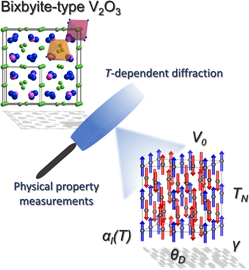Article contents
Physical properties and lattice dynamics of bixbyite-type V2O3
Published online by Cambridge University Press: 15 May 2017
Abstract

Some time ago, we reported the synthesis of bixbyite-type V2O3, a new metastable polymorph of vanadium sesquioxide. Since, a number of investigations followed, dealing with different aspects like electronic and magnetic properties of the material, the deviation from ideal stoichiometry or the preparation of nanocrystals as oxygen storage material. However, most of the physical properties were only evaluated on a theoretical basis. Here, we report the lattice dynamics and physical properties of bixbyite-type V2O3 bulk material, which we acquired from physical property measurements and neutron diffraction experiments over a wide temperature range. Besides attributing different possible orientations of the magnetic moments for V1 and V2 to the identified antiferromagnetic (AFM) ground state with a Néel temperature of 38.1(5) K, we use a first order Grüneisen approximation to determine lattice-dependent parameters for the relatively stiff cubic lattice, and, amongst others identify the Debye temperature to be as low as 350 ± 65 K.
- Type
- Articles
- Information
- Copyright
- Copyright © Materials Research Society 2017
Footnotes
Contributing Editor: Michael E. McHenry
References
REFERENCES
- 3
- Cited by





